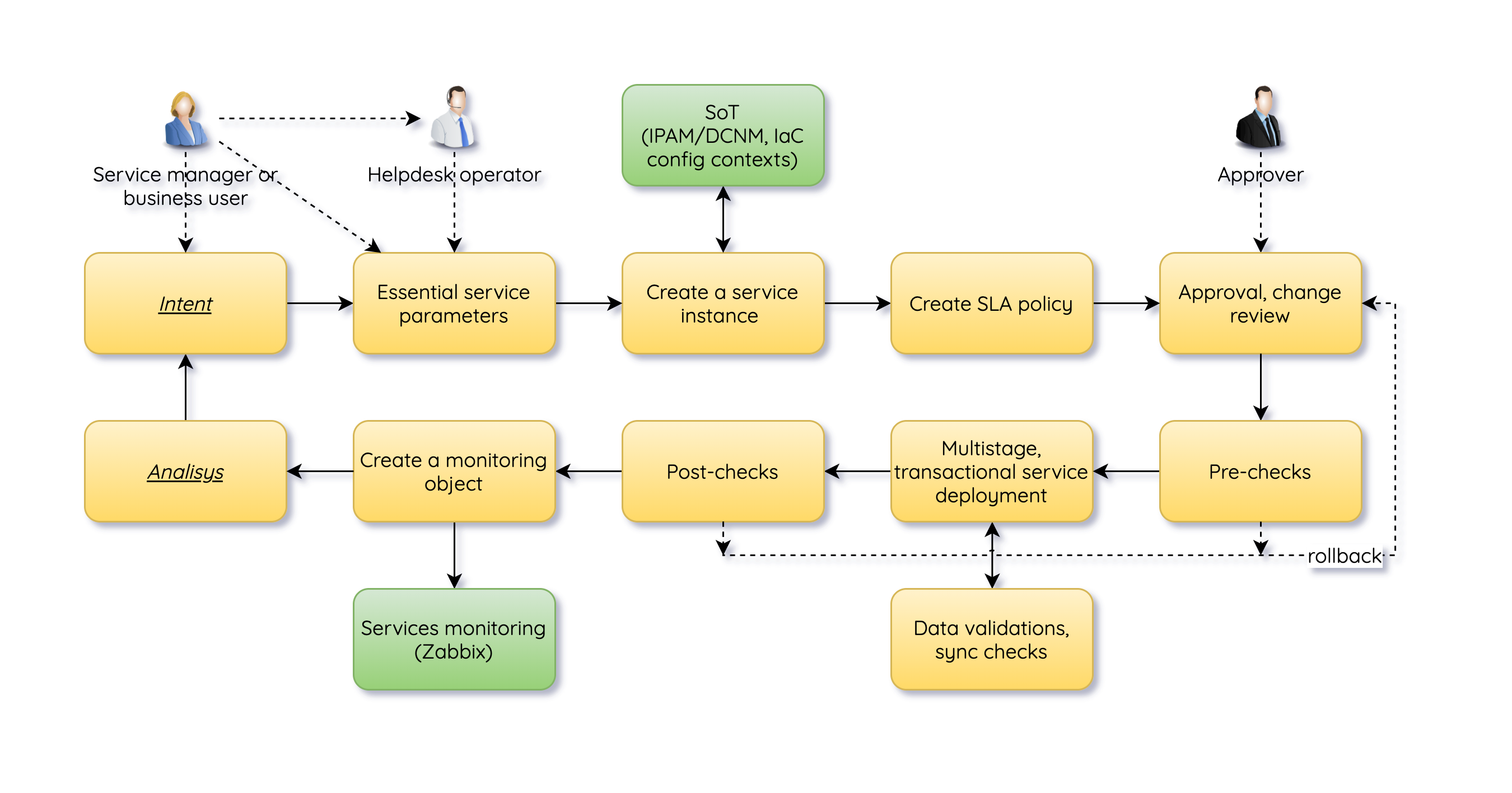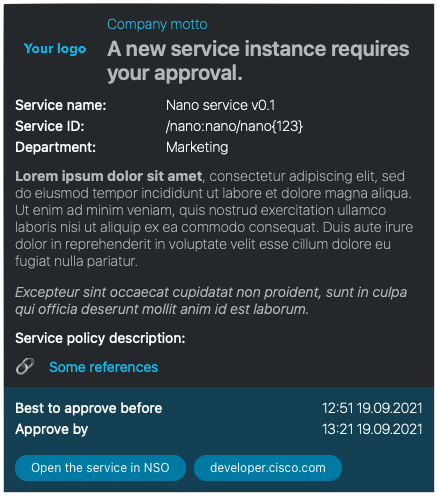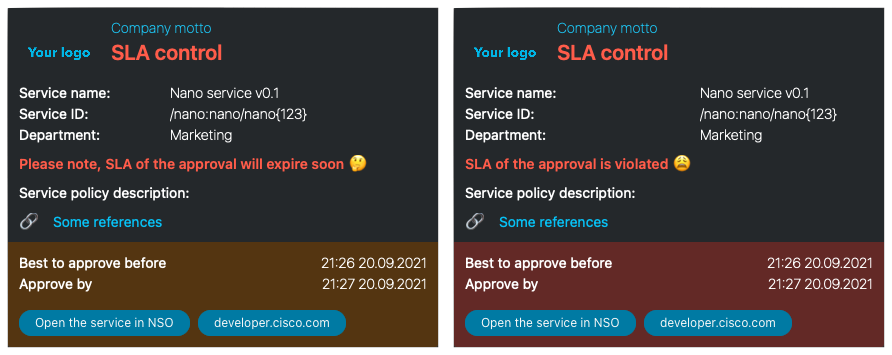Cisco Network Services Orchestration (NSO) has a pretty comprehensive toolset to do configuration and service management in a very reliable manner, which includes model-based network-wide transactions, rollbacks, input data validation, etc. Service developers can extend this functionality even further with the traditional CI/CD approach to add pipelines with testing and deployment steps. A great example is Julio Gomez’s work, which is based on NSO, Ansible, and GitLab CI/CD pipelines.
However, NSO has an embedded functionality to implement full CI/CD pipelines with the help of Nano services.
What are Nano services
Nano services are an evolution of Reactive FASTMAP and other design patterns like subscribers and kickers. Nano services will allow you to describe a high-level logic of the service and your pipeline with no or low code. You may start with just YANG models and XML config templates. Oh, some XPath is still there, but not too much. The main benefit of a Nano service is that you get a bullet-proof framework to divide your complicated service into small states with clear conditions to in and out between them. This design pattern allows you to focus on your service logic instead of controlling the consistency of configurations and rollbacks.
You may use Nano services in so many different ways. It could be a network or device service provisioning divided into small parts, having separate diffs, and executing in your defined order. For example, configure some QoS on one device before enabling VoIP functions on another.
Moreover, Nano services shine when integration with other systems or NSO services is desirable, especially when different parts of the service will be ready at different times in an async manner. For example, request a VM creation and stop executing a pipeline; continue when VM is ready.

This repo contains an example of an NSO service, named nano, to demonstrate
some possible features:
- define states of the service in YANG format, including conditions, and callbacks to start provision of parts of the service or call NSO actions
- use template-based device configuration with YANG and XML only, with adding Python for some parts if needed
- continue execution of next states automatically if pre-conditions are meet sometime; for example, post-tests finished with positive results
- pre and post-tests (NSO runs a command, pyATS parses the output)
- control of approvals of service with NETCONF Access Control Model (NACM)
- track and log execution progress of the states, including SLA tracking of created instances via Service Progress Monitoring policy of NSO
- modify, delete, rollback to a particular state, and re-apply the service
- Notify users via Webex bot
Network sophisticated configurations or core features of NSO aren’t shown here since they deserve separate showcases. I tried to keep this example runnable by any user without excessive requirements to have a full-blown network sandbox and access to the actual version of production NEDs. A demo version of NSO, a Linux or macOS host, and Python is what you need.
Some ideas are worth considering to extend functionality further.
- full lifecycle management of monitoring objects in external monitoring systems based on configured network services
- management of resource allocations via external SoT systems, like IPAM and
DCNM, or an internal native
NSO Resource Managerpackage - closed-loop automation with the help of middleware software to translate webhooks from the monitoring system to NSO NB interfaces to change parameters of the service
- extending testing functionality with frameworks like
pyATS,scrapli,pytest - separating a Webex notification action or testing actions to separate packages for easy consumption in other services
A word of caution. NSO is capable of doing a lot of things. Even so, there is always a balance of doing it with internal tools or using an external feature-rich and purpose-built toolset. In many cases splitting functionality between NSO and other systems or frameworks may benefit your service in better stability, functionality, maintainability, and faster development.
Please note, that CI/CD for developing of NSO services itself is not covered in this use case.
Usage
Init the service
A Service Progress Monitoring policy should be created to be used by nano
service instances. In real-life deployment, it’s a one-time command, so it is
implemented as a manual process.
To init a Service Progress Monitoring policy, run make cli. A default password
for the user admin is admin.
User admin last logged in 2021-09-18T15:29:01.25052+00:00, to localhost, from 127.0.0.1 using cli-console
admin connected from 127.0.0.1 using console on localhost
admin@ncs# nano sla init-sla-policy
SPM policy will be created or updated with SLA timeouts, are you sure? [yes,no] yes
result true
msg OK
admin@ncs#
System message at 2021-09-18 18:30:48...
Commit performed by admin via tcp using nano_helper.spm.
admin@ncs# show running-config service-progress-monitoring
service-progress-monitoring policy nano-sla-policy
violation-timeout 3600
jeopardy-timeout 1800
condition self-ready
component-type self
what all
plan-state ready
status reached
!
!
action action-path /nano/sla/timeouts/timeout
action always-call true
!
admin@ncs#
Optionally you may change SLA timeouts of this policy.
admin@ncs# c
admin@ncs# config
Entering configuration mode terminal
admin@ncs(config)# nano sla timeouts ?
Possible completions:
jeopardy Jeopardy timeout, minutes
timeout Manually send SLA notifications
violation Violation timeout, minutes
admin@ncs(config)# nano sla timeouts jeopardy 1 violation 2
admin@ncs(config)# commit dry-run
cli {
local-node {
data nano {
sla {
timeouts {
+ jeopardy 1;
+ violation 2;
}
}
}
}
}
admin@ncs(config)# commit
Commit complete.
admin@ncs(config)#
System message at 2021-09-18 18:33:54...
Commit performed by system via tcp using nano_helper.spm.
admin@ncs(config)# do show running-config service-progress-monitoring
service-progress-monitoring policy nano-sla-policy
violation-timeout 120
jeopardy-timeout 60
condition self-ready
component-type self
what all
plan-state ready
status reached
!
!
action action-path /nano/sla/timeouts/timeout
action always-call true
!
admin@ncs(config)# exit
admin@ncs#
Configure the service
Network Configuration Access Control Model or NACM rules don’t enforce a local
connection; you need to log in through SSH. We will use a user engineer who
has full access to the system and the service except for the approved flag.
For this user, use password engineer.
$ make cli-en
ssh [email protected] -p 2024 -o PreferredAuthentications=password -o PasswordAuthentication=yes -o PubkeyAuthentication=no
[email protected]'s password:
engineer connected from 127.0.0.1 using ssh on localhost
engineer@ncs# c
engineer@ncs# config
Entering configuration mode terminal
engineer@ncs(config)# nano nano 123\
>
engineer@ncs# c
engineer@ncs# config
Entering configuration mode terminal
engineer@ncs(config)# nano nano 123
Value for 'device' [r0,r1]: r0
engineer@ncs(config-nano-123)# ?
Possible completions:
check-sync Check if device config is according to the service
commit-queue
deep-check-sync Check if device config is according to the service
device Attached device
get-modifications Get the data this service created
log
name-server Name server
notify Service notifications
plan
re-deploy Run/Dry-run the service logic again
reactive-re-deploy Reactive re-deploy of service logic
tests Run tests
touch Mark the service as changed
un-deploy Undo the effects of the service
---
commit Commit current set of changes
describe Display transparent command information
exit Exit from current mode
help Provide help information
no Negate a command or set its defaults
pwd Display current mode path
rload Load configuration from an ASCII file or from terminal, relative to current location
top Exit to top level and optionally run command
engineer@ncs(config-nano-123)# commit dry-run
cli {
local-node {
data service-progress-monitoring {
+ trigger nano-spm-123 {
+ policy nano-sla-policy;
+ component self;
+ target /nano/nano[id='123'];
+ }
}
nano {
+ nano 123 {
+ device r0;
+ }
}
}
}
engineer@ncs(config-nano-123)# commit
Commit complete.
engineer@ncs(config-nano-123)#
System message at 2021-09-19 12:21:06...
Commit performed by engineer via system using cli.
engineer@ncs(config-nano-123)# end
engineer@ncs# show running-config nano
nano nano 123
device r0
no approved
!
nano sla webex room-id %ENV{WEBEX_ROOM_ID}
nano sla webex bot-token %ENV{WEBEX_BOT_TOKEN}
engineer@ncs# show nano
nano nano 123
plan-location /nano/nano[id='123']
BACK POST ACTION
TYPE NAME TRACK GOAL STATE STATUS WHEN ref STATUS
-----------------------------------------------------------------------------------------------------------
self self false - init reached 2021-09-19T09:21:03 - -
ready not-reached - - -
sla-com-type sla false - init reached 2021-09-19T09:21:03 - -
trigger-created reached 2021-09-19T09:21:03 - -
ready reached 2021-09-19T09:21:03 - -
cfg-com-type config false - init reached 2021-09-19T09:21:03 - -
approver-notif reached 2021-09-19T09:21:03 - create-reached
approved not-reached - - -
pre-test not-reached - - -
banner-cfg not-reached - - -
name-server-cfg not-reached - - -
post-test not-reached - - -
ready not-reached - - -
JEOPARDY VIOLATION SUCCESS
NAME POLICY START TIME JEOPARDY TIME RESULT VIOLATION TIME RESULT STATUS TIME
-------------------------------------------------------------------------------------------------------------------------------------
nano-spm-123 nano-sla-policy 2021-09-19T12:21:03 2021-09-19T12:51:03 - 2021-09-19T13:21:03 - running -
engineer@ncs#
The Nano service plan in WebUI:

Note that the user cannot add the approved flag to the service configuration
because of the statically defined NACM rules in the
configs/nacm.xml file.
The sla component is responsible for creating an SPM trigger to track the SLA
of our service instance.
Also, note that config component is stopped on approver-notif state. That
means, we need an another user to login and change configuration of the service
by adding approved flag.
Approve the service
approver user got a notification.

Log in to NSO with the user approver and password approved. Pay attention,
that approver cannot change service’s configuration; commands device and
name-server are not visible or accessible.
$ make cli-app
ssh [email protected] -p 2024 -o PreferredAuthentications=password -o PasswordAuthentication=yes -o PubkeyAuthentication=no
[email protected]'s password:
approver connected from 127.0.0.1 using ssh on localhost
approver@ncs# c
approver@ncs# config
Entering configuration mode terminal
approver@ncs(config)# nano nano 123
approver@ncs(config-nano-123)# dev?
^
% Invalid input detected at '^' marker.
approver@ncs(config-nano-123)# ?
Possible completions:
approved Approved flag
check-sync Check if device config is according to the service
commit-queue
deep-check-sync Check if device config is according to the service
get-modifications Get the data this service created
log
notify Service notifications
plan
re-deploy Run/Dry-run the service logic again
reactive-re-deploy Reactive re-deploy of service logic
tests Run tests
touch Mark the service as changed
un-deploy Undo the effects of the service
---
commit Commit current set of changes
describe Display transparent command information
exit Exit from current mode
help Provide help information
no Negate a command or set its defaults
pwd Display current mode path
rload Load configuration from an ASCII file or from terminal, relative to current location
top Exit to top level and optionally run command
approver@ncs(config-nano-123)# approved
approver@ncs(config-nano-123)# commit dry-run
cli {
local-node {
data nano {
nano 123 {
+ approved true;
}
}
}
}
approver@ncs(config-nano-123)# commit
Commit complete.
approver@ncs(config-nano-123)#
System message at 2021-09-19 12:26:51...
Commit performed by approver via ssh using cli.
approver@ncs(config-nano-123)#
System message at 2021-09-19 12:26:52...
Commit performed by approver via system using cli.
approver@ncs(config-nano-123)#
System message at 2021-09-19 12:26:52...
Commit performed by approver via system using cli.
approver@ncs(config-nano-123)#
System message at 2021-09-19 12:26:53...
Commit performed by approver via system using cli.
approver@ncs(config-nano-123)#
System message at 2021-09-19 12:26:53...
Commit performed by approver via system using cli.
approver@ncs(config-nano-123)#
System message at 2021-09-19 12:26:53...
Commit performed by approver via system using cli.
approver@ncs(config-nano-123)# end
approver@ncs#
approver@ncs# show running-config nano
nano nano 123
device r0
approved
!
nano sla webex room-id %ENV{WEBEX_ROOM_ID}
nano sla webex bot-token %ENV{WEBEX_BOT_TOKEN}
approver@ncs(config)# exit
approver@ncs#
Once the approved flag is committed, a series of commits will finish all
subsequent steps, including pre-test, change a banner and a name server,
post-test. As a part of SPM policy, a notification will be send.

In case of missed SLA, separate notifications will be sent by SPM policy trigger.

The plan
Check the executed plan of our service instance and generated and delivered device configuration in NSO native format.
approver@ncs# show nano
nano nano 123
modified devices [ r0 ]
directly-modified devices [ r0 ]
device-list [ r0 ]
plan-location /nano/nano[id='123']
BACK POST ACTION
TYPE NAME TRACK GOAL STATE STATUS WHEN ref STATUS
-------------------------------------------------------------------------------------------------------
self self false - init reached 2021-09-19T09:21:03 - -
ready reached 2021-09-19T09:26:53 - -
sla-com-type sla false - init reached 2021-09-19T09:21:03 - -
trigger-created reached 2021-09-19T09:21:03 - -
ready reached 2021-09-19T09:21:03 - -
cfg-com-type config false - init reached 2021-09-19T09:21:03 - -
approver-notif reached 2021-09-19T09:21:03 - create-reached
approved reached 2021-09-19T09:26:51 - -
pre-test reached 2021-09-19T09:26:51 - create-reached
banner-cfg reached 2021-09-19T09:26:51 - -
name-server-cfg reached 2021-09-19T09:26:52 - -
post-test reached 2021-09-19T09:26:53 - create-reached
ready reached 2021-09-19T09:26:53 - -
JEOPARDY VIOLATION
NAME POLICY START TIME JEOPARDY TIME RESULT VIOLATION TIME RESULT STATUS SUCCESS TIME
----------------------------------------------------------------------------------------------------------------------------------------------------
nano-spm-123 nano-sla-policy 2021-09-19T12:21:03 2021-09-19T12:51:03 passed 2021-09-19T13:21:03 passed successful 2021-09-19T12:26:53
approver@ncs(config)# nano nano 123 get-modifications
cli {
local-node {
data devices {
device r0 {
config {
ip {
domain {
+ list example.com {
+ }
lookup-conf {
+ lookup true;
}
+ name example.com;
}
name-server {
+ name-server-list 208.67.222.222 {
+ }
}
}
banner {
+ motd "The message of the day";
}
}
}
}
service-progress-monitoring {
+ trigger nano-spm-123 {
+ policy nano-sla-policy;
+ component self;
+ target /nano/nano[id='123'];
+ }
}
}
}
approver@ncs(config)# exit
approver@ncs#
Delete the service
To entirely delete the service instance, you need to remove the SLA policy firstly.
admin@ncs(config)# end
admin@ncs# c
admin@ncs# config
Entering configuration mode terminal
admin@ncs(config)# nano nano 123
admin@ncs(config-nano-123)# plan ?
Possible completions:
component A component has a type and a list of states.
admin@ncs(config-nano-123)# plan component ?
Possible completions:
cfg-com-type self sla-com-type
admin@ncs(config-nano-123)# plan component sla-com-type sla ?
Possible completions:
force-back-track Force a component to back-track
state A plan state represents a certain step or stage that a service needs to execute and/or reach.
admin@ncs(config-nano-123)# plan component sla-com-type sla force-back-track
result true
admin@ncs(config-nano-123)# no nano nano 123
admin@ncs(config)# commit dry-run
cli {
local-node {
data devices {
device r0 {
config {
ip {
domain {
- list example.com {
- }
lookup-conf {
- lookup true;
}
- name example.com;
}
name-server {
- name-server-list 208.67.222.222 {
- }
}
}
banner {
- motd "The message of the day";
}
}
}
}
nano {
- nano 123 {
- device r0;
- approved true;
- }
}
}
}
admin@ncs(config)# commit
Commit complete.
admin@ncs(config)#
System message at 2021-09-19 12:41:20...
Commit performed by admin via system using cli.
admin@ncs(config)#
System message at 2021-09-19 12:41:20...
Commit performed by admin via system using cli.
admin@ncs(config)#
System message at 2021-09-19 12:41:20...
Commit performed by admin via system using cli.
admin@ncs(config)#
System message at 2021-09-19 12:41:20...
Commit performed by admin via system using cli.
admin@ncs(config)#
You may experiment a bit, revoke your approval, and see how NSO will back-track
all the changes that cannot exist without the approve flag.
Related Sandbox
Links to DevNet Learning Labs
NSO learning labs are a great way to explore capabilities and NSO and start learning:
Another option is to install NSO in Local Install mode and learn in your own pace. For references check README.md.